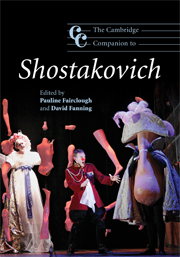Book contents
- Frontmatter
- Introduction
- PART I Instrumental works
- 1 Personal integrity and public service: the voice of the symphonist
- 2 The string quartets: in dialogue with form and tradition
- 3 Paths to the First Symphony
- 4 Shostakovich's Second Piano Sonata: a composition recital in three styles
- 5 ‘I took a simple little theme and developed it’: Shostakovich's string concertos and sonatas
- PART II Music for stage and screen
- PART III Vocal and choral works
- PART IV Performance, theory, reception
- Notes
- Select bibliography
- Index
3 - Paths to the First Symphony
from PART I - Instrumental works
Published online by Cambridge University Press: 28 September 2011
- Frontmatter
- Introduction
- PART I Instrumental works
- 1 Personal integrity and public service: the voice of the symphonist
- 2 The string quartets: in dialogue with form and tradition
- 3 Paths to the First Symphony
- 4 Shostakovich's Second Piano Sonata: a composition recital in three styles
- 5 ‘I took a simple little theme and developed it’: Shostakovich's string concertos and sonatas
- PART II Music for stage and screen
- PART III Vocal and choral works
- PART IV Performance, theory, reception
- Notes
- Select bibliography
- Index
Summary
Talent is the capacity to learn, genius the capacity to develop oneself.
Symphonic debuts by teenage composers are dotted through the history of Western music from Mozart to Jay Greenberg. Occasionally such works hit the headlines – as in 1882 when the sixteen-year-old Glazunov was hailed as a renewer of the Russian nationalist symphonic tradition – but do not gain a foothold in the repertoire. Occasionally recognition comes belatedly but more firmly, as with Bizet's delectable Symphony in C, composed when he was an eighteen-year-old student in 1855 on the model of Gounod's First Symphony but only premiered eighty years later. It can happen that repertoire status is gradually and unsensationally achieved, as with the nineteen-year-old Schubert's Fifth Symphony, parts of which he closely modelled on Mozart's G minor, KV550. Rarely, however, does such a work both make an extraordinary initial impact and maintain unquestioned repertoire status. Such a case is undoubtedly Shostakovich's First, the work of an eighteen-year-old, and one for which no obvious model can be named, but which itself inspired successors not just among his Soviet elders and juniors but in realms as far-flung as Greece, Finland and Soviet Mongolia.
The piece scored a famous triumph at its premiere under Nikolay Malko on 12 May 1926 in the Great Hall of the Leningrad Philharmonic, an event whose anniversary the composer would commemorate for the rest of his life. His teacher Maximilian Steinberg noted in his diary that evening: ‘A memorable concert. Tumultuous success for Mitya's symphony: they encored the scherzo.’ The symphony was taken up by Bruno Walter (Berlin, 5 May 1927), Leopold Stokowski (Philadelphia, 2 November 1928), Robert Hager (28 November 1928) and Arturo Toscanini (from 1931), inaugurating an international reputation that has dimmed only slightly as that of Shostakovich’s subsequent symphonies has flared. Congratulatory messages came from figures as geographically and artistically distant as Berg in Vienna and Milhaud in Paris.
- Type
- Chapter
- Information
- The Cambridge Companion to Shostakovich , pp. 70 - 94Publisher: Cambridge University PressPrint publication year: 2008

